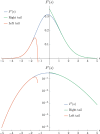Half-Space Stationary Kardar-Parisi-Zhang Equation
- PMID: 33087988
- PMCID: PMC7567743
- DOI: 10.1007/s10955-020-02622-z
Half-Space Stationary Kardar-Parisi-Zhang Equation
Abstract
We study the solution of the Kardar-Parisi-Zhang (KPZ) equation for the stochastic growth of an interface of height h(x, t) on the positive half line, equivalently the free energy of the continuum directed polymer in a half space with a wall at . The boundary condition corresponds to an attractive wall for , and leads to the binding of the polymer to the wall below the critical value . Here we choose the initial condition h(x, 0) to be a Brownian motion in with drift . When , the solution is stationary, i.e. remains at all times a Brownian motion with the same drift, up to a global height shift h(0, t). We show that the distribution of this height shift is invariant under the exchange of parameters A and B. For any , we provide an exact formula characterizing the distribution of h(0, t) at any time t, using two methods: the replica Bethe ansatz and a discretization called the log-gamma polymer, for which moment formulae were obtained. We analyze its large time asymptotics for various ranges of parameters A, B. In particular, when , the critical stationary case, the fluctuations of the interface are governed by a universal distribution akin to the Baik-Rains distribution arising in stationary growth on the full-line. It can be expressed in terms of a simple Fredholm determinant, or equivalently in terms of the Painlevé II transcendent. This provides an analog for the KPZ equation, of some of the results recently obtained by Betea-Ferrari-Occelli in the context of stationary half-space last-passage-percolation. From universality, we expect that limiting distributions found in both models can be shown to coincide.
Keywords: Growth process; Halfspace; Kardar–Parisi–Zhang; Lieb–Liniger; Random matrix theory; Stationary measure.
© The Author(s) 2020.
Figures






Similar articles
-
Maximum of an Airy process plus Brownian motion and memory in Kardar-Parisi-Zhang growth.Phys Rev E. 2017 Dec;96(6-1):060101. doi: 10.1103/PhysRevE.96.060101. Epub 2017 Dec 7. Phys Rev E. 2017. PMID: 29347397
-
One-dimensional Kardar-Parisi-Zhang equation: an exact solution and its universality.Phys Rev Lett. 2010 Jun 11;104(23):230602. doi: 10.1103/PhysRevLett.104.230602. Epub 2010 Jun 11. Phys Rev Lett. 2010. PMID: 20867222
-
Kardar-Parisi-Zhang equation in a half space with flat initial condition and the unbinding of a directed polymer from an attractive wall.Phys Rev E. 2021 Aug;104(2-1):024502. doi: 10.1103/PhysRevE.104.024502. Phys Rev E. 2021. PMID: 34525573
-
Exact solution for the Kardar-Parisi-Zhang equation with flat initial conditions.Phys Rev Lett. 2011 Jun 24;106(25):250603. doi: 10.1103/PhysRevLett.106.250603. Epub 2011 Jun 24. Phys Rev Lett. 2011. PMID: 21770622
-
Theory and experiments for disordered elastic manifolds, depinning, avalanches, and sandpiles.Rep Prog Phys. 2022 Aug 9;85(8). doi: 10.1088/1361-6633/ac4648. Rep Prog Phys. 2022. PMID: 35943081 Review.
References
-
- Kardar M, Parisi G, Zhang Y-C. Dynamic scaling of growing interfaces. Phys. Rev. Lett. 1986;56:889. - PubMed
-
- Baik, J., Rains, E.M.: Symmetrized random permutations, and in Random matrix models and their applications, vol. 40 of Math. Sci. Res. Inst. Publ., pp. 1–19. Cambridge University Press (2001) arXiv:math/9910019
-
- Prahofer, M., Spohn, H.: Current fluctuations for the totally asymmetric simple exclusion process, progress in Probability, vol. 51, edited by V. Sidoravicius (Birkhauser, Boston, 2002) 185, arXiv:cond-mat/0101200
-
- Spohn H. Exact solutions for KPZ-type growth processes, random matrices, and equilibrium shapes of crystals. Physica A. 2006;369(1):71.
-
- Ferrari, P.L.: From interacting particle systems to random matrices. J. Stat. Mech. P10016 (2010)
LinkOut - more resources
Full Text Sources
